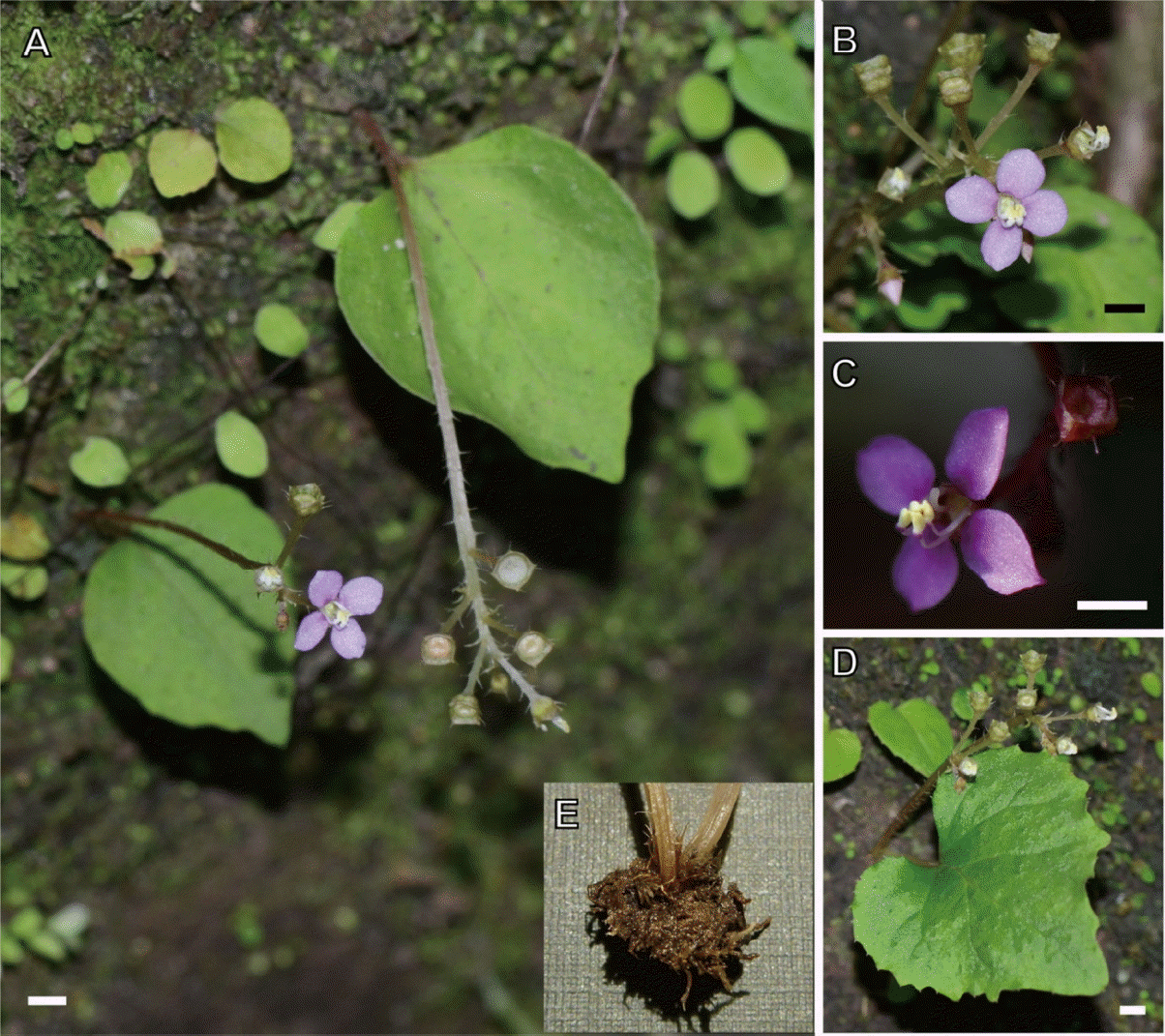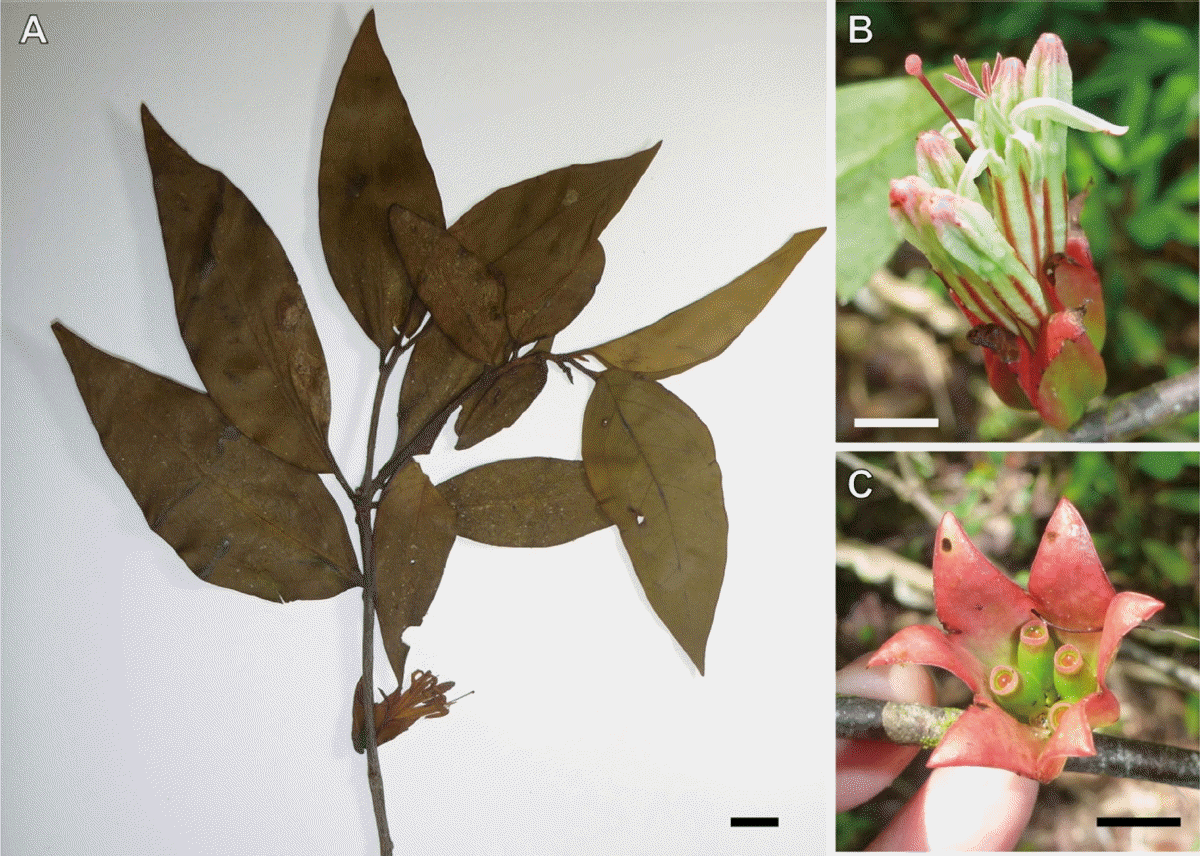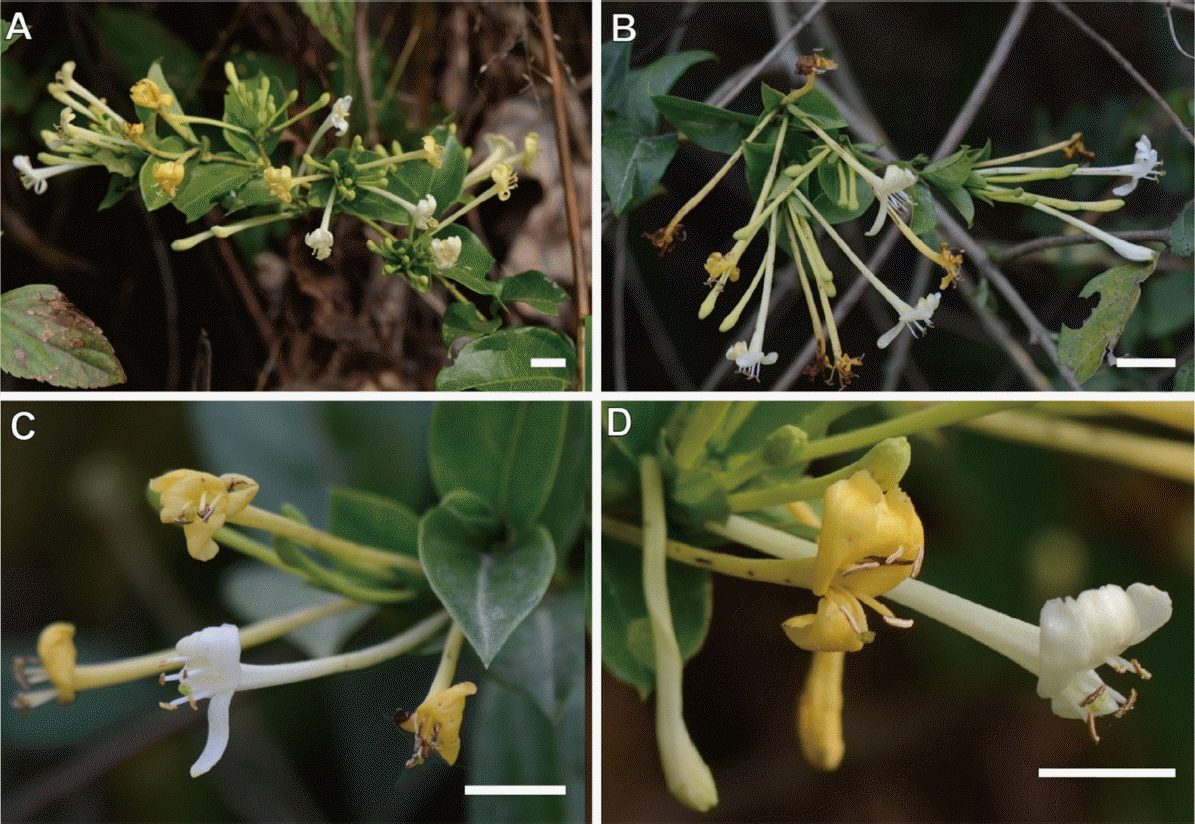라오스 미기록 현화식물
New records of flowering plants from Lao PDR
Article information
Abstract
2015–2016년 사이 라오스 식물상을 조사하는 과정에서 발견한 미기록 현화식물을 보고한다. 라오스 푸카오쿠오아이 국가생물다양성보전지구에서 야목단과(Melastomataceae)의 Phyllagathis tuberosa (C. Hansen) Cellinese & S. S. Renner와 꼬리겨우살이과(Loranthaceae)의 Tolypanthus pustulatus Barlow를 발견하였으며, 이들은 태국의 기준표본 채집지 외에는 아직까지 채집된 바 없는 종들로, 라오스에 분포하는 것을 처음으로 확인하였다. 한편, 인동과(Caprifoliaceae)의 Lonicera bournei Hemsl.는 20세기초 라오스에 분포하는 것으로 보고된 바 있으나 이후 채집 기록이 없다가, 라오스 시앙쾅주 포사보국가보호지구에서 다시 발견하였다. 본 연구의 결과는 라오스 및 동남아시아 국가의 식물상 및 그 특성을 규명하는 데 도움이 될 것으로 기대된다.
Trans Abstract
We report previously unrecognized flowering plants of Lao PDR found during a botanical survey of Lao PDR in 2015–2016. We found Phyllagathis tuberosa (C. Hansen) Cellinese & S. S. Renner (Melastomataceae) and Tolypanthus pustulatus Barlow (Loranthaceae) in the Phou Khao Khouay National Biodiversity Conservation Area (PKKNBCA), previously only known from type localities in Thailand. This is the first report of Phyllagathis tuberosa and the genus Tolypanthus in the Lao PDR. We also found Lonicera bournei Hemsl. (Caprifoliaceae) in the proposed Phosabous National Protected Area (PNPA) of Xiangkhoang, neglected with regard to the flora of Laos since its initial report in early 20th century. The current report will augment our understanding of the floristic relationships among SE Asian countries and will help elucidate the biodiversity of Lao PDR.
Lao People’s Democratic Republic (PDR) is located in the heart of Indochinese peninsula, bordered by Myanmar and China to the northwest, Vietnam to the east, Cambodia to the South, and Thailand to the west and southwest (Fig. 1). Lao PDR ranges from 14° to 23° N and 100° to 108°E, and the area is 237,955 km2. The highest mountain of Lao PDR is Mt. Phou Bia at 2,818 m, and Mekong River forms the western border with Thailand and the mountains of Annamite range forms eastern border with Vietnam. The climate of Laos is tropical with distinct monsoon pattern, i.e., rainy season from May to November and dry season from December to April (http://www.na.gov.la/appf17/geography.html). The flora of Lao PDR is one of the least known in Asia, due to mainly lack of collection and research on the flora (Newman et al., 2007). Early botanical collections were made mainly by French collectors, such as Clovis Thorel, Jules Harmand, Henri D’Orléans, Clément Dupuy, Jean-Baptiste Counillon, Eugène Poilane, Camile Joseph Spire, Jules Vidal, Pierre Tixier, and Allen D. Kerr until 1960s, though there is little during 1940–1980s (Gagnepain, 1944; Newman et al., 2007; Inthakoun and Delang, 2008). Newman et al. (2007) compiled a checklist for vascular plants of Lao PDR, based on Callaghan’s “Checklist of Lao Plant Names” (Callaghan, 2004), Flore du Cambodge, du Laos du Viêtnam (Aubréville and Leroy, 1960–2014), and collection records in Museum National d’Histoire Naturelle (P), Royal Botanic Gardens Edinburgh (E), and Nationaal Herbarium Nederland (L). The checklist includes 4,850 vascular plants for Lao PDR, which is less than half of the number of species reported for Vietnam (Canh and Hai, 2010), Myanmar (Kress et al., 2003), and Thailand (Santisuk et al., 2006). The close geographic location and similar climate suggest there exist common floristic components in Indochinese countries, together with high endemism, but lack of collection and floristic research have hindered the assessment of biodiversity of the region (Middleton, 2015).

Map showing the collection sites of the three rarely known flowering plant species of Lao PDR. Triangles indicate Phyllagathis tuberosa, circles Tolypanthus pustulatus, and diamonds Lonicera bournei, respectively. Closed ones indicate collection sites of Laos, open ones indicate type localities of P. tuberosa and T. pustulatus, or previously reported collection site of L. bournei.
As an ongoing cooperative project between the National Institute of Biological Resources (NIBR), Ministry of Environment, Republic of Korea and the Ministry of Natural Resources and Environment, Lao PDR, we have been collecting flowering plants from Phou Khao Khouay National Biodiversity Conservation Area (PKKNBCA), stretched over Vientiane and Bolikamxai provinces and Phosabous National Protected Area (PNPA), Xiangkhoang Province since 2015 (Fig. 1). PKKNBCA is located ca. 60 km NE of Vientiane, the capital of Lao PDR. PKKNBCA covers large area and ranges from 100 m to 1,600 m in elevation, but currently we only covered area below 800 m. PKKNBCA ranges from evergreen Dipterocarp forest to coniferous forest and grassland, and the biodiversity of the forest is threatened by roads and villages (Soukhavong et al., 2013; Nanthavong, 2015). Regarding the flora, only ample study was done, such as Soukhavong et al. (2013). The PNPA is located NE of Phonsavan, the capital of Xiangkhoang province, and ranges from 900 m to 1,600 m. The PNPA is mostly consisted of steep mountains, with high level of disturbance from extensive shifting cultivation on mountain slopes and ridges by local villagers applying rotational slash-and-burn agriculture (Lehmann et al., 2003). There was no floristic study done for the area, except work of Lehmann et al. (2003) on the tree species around “Plain of Jars”. So far, we have visited the PKKNBCA and PNPA three times in December 2015 and February and August of 2016, making ca. 1,000 collections. While we are identifying specimens, we encountered species rarely reported for science and also new to Lao PDR. Here we are presenting descriptions and pictures of three rarely known species, such as Phyllagathis tuberosa (C. Hansen) Cellinese & S. S. Renner (Melastomataceae) and Tolypanthus pustulatus Barlow (Loranthaceae), which have only been reported from type collections made in Thailand, and Lonicera bournei Hemsl. (Caprifoliaceae), which has been overlooked more than a hundred year since its first report by Danguy (1922). Presence of those rarely known species in Lao PDR suggests that there are many more common floristic components in SE Asian countries, and thus further botanical surveys and studies are indispensable to elucidate the biodiversity and flora of the region.
Taxonomic Treatment
Melastomataceae Juss
Phyllagathis tuberosa (C. Hansen) Cellinese & S. S. Renner, Novon 7: 109, 1997 (Fig. 2). Tylanthera tuberosa C. Hansen, Nord. J. Bot. 9: 632, 1990.—TYPE: Thailand. Northern Phitsanulok, Phu Mieng mountain, elev. 700 m, Jul–Aug 1966, Larsen et al. 1105 (holotype, AAU [not seen]; isotypes, BKF [not seen], C [photo at Jstor!]).

Phyllagathis tuberosa (Melastomataceae) at Phou Khao Khouay National Biodiversity Conservation Area. A. Habit. B, C. Inflorescence and flower, B: shaded place, C: open place. D. Leaf with denticulate leaf margin. E. Rhizome. Scale bars = 2 mm.
Small acaulescent herbs, 3–10 cm tall, sparsely hairy with pilose glandular hairs; rhizome tuberous, flattened, 4–10 mm in diam., covered with brown hairs. Leaves usually one; petioles green to reddish, 1–3 cm long, sparsely pilose; blade ovate to broadly ovate, 2–4 × 1–3.5 cm, apex acute to obtuse, base truncate to cordate, margin entire to slightly denticulate, finely ciliate, membranous, 3–5 nerved, sparsely pilose on both surface. Inflorescences a scorpioid cyme with 3–8 flowers, peduncle 2–6 cm long, green to reddish; bracts linear, ca. 1 mm long; pedicels 3–4 mm long; peduncles and pedicels with sparse pilose glandular hairs. Flowers bisexual, 4-merous, subtended by two bracts; hypanthium campanulate, 1 mm long, 1.2 mm wide, sparsely covered with pilose glandular hairs; calyx lobes ca. 0.2–0.3 mm long, acuminate; petals ovate to suborbicular, 3.5 mm long, apex acute to rounded, pink; stamens 4, isomorphic, alternate with petals, opposite to calyx lobes; filaments ca. 1.2 mm long, curved upward; anthers yellowish, aggregated and upright, 1 mm long, connective with a small dorsal appendage; ovary 4-locular, 0.8–1 mm long, almost completely adnate to the hypanthium, apically rounded; style slightly curved upward toward stigma, 2 mm long. Capsules campanulate, ca. 1.5 mm long and wide; placentae stalked. Seeds ellipsoid, 0.3–0.5 mm long; testa tuberculate.
Phenology: flowering and fruiting July–August.
Distribution: Laos, Thailand; elev. 300–800 m, growing on rocks by a stream, in shaded forest.
Specimen examined: LAO PDR. Vientiane: Thoulakhom District, along the unpaved road (Phou Khao Khouay Trail) between the Vang Hua village and Ban Namyam, at steep stream forming waterfall falling down to the road, PKKNBCA, 18°21′17.1″N, 102°45′11.9″E, elev. 749 m, 21 Aug 2016, Won et al. 15354 (DGU). Bolikamxai: Thaphabat District, about 200 m south of the Tad Xai waterfall, PKKNBCA, 18°27′09.6″N, 103°08′32.0″E, elev. 320 m, 23 Aug 2016, Won et al. 15484 (DGU).
Phyllagathis Blume is an endemic genus of SE Asia and consisted of ca. 56 species (Cellinese, 1997, 2002). It is distributed from South China, Vietnam, Laos, Thailand, and West Malaysia to Sumatra and Borneo. Phyllagathis is characterized by 4-merous flowers but some species have 5-merous flowers even within a same species (Cellinese, 2002; Wangwasit et al., 2010). Tylanthera, which are characterized by acaulescent habit with 4-merous, haplostemonous flowers, consisted of two species—T. tuberosa C. Hansen and T. cordata C. Hansen (≡ P. siamensis Cellinese & S. S. Renner) (Hansen, 1990), was merged to Phyllagathis by Cellinese and Renner (1997). A third species having acaulescent habit with a tuberous rhizome, P. nanakorniana Wangwasit, Norsaengsri & Cellinese was also recognized from Thailand (Wangwasit et al., 2010). Phyllagathis tuberosa is distinct from the two species in that P. tuberosa is much smaller than P. siamensis in size (2–5 cm vs. 25–30 cm long in leaf length) and having scorpioid cyme contrary to umbel of P. siamensis, however, and has only 4 fertile stamens unlike 8 dimorphic stamens (4 fertile and 4 sterile staminodes) of P. nanakorniana. Cellinese (2002) recognized P. tuberosa as one of the tiniest species in the genus. This species has only been known from the type material collected from Thailand (Hansen, 1990; Cellinese, 2002), until the current report. We found P. tuberosa from two sites in PKKNBCA, one western part belonging to Vientiane Province, the other on eastern part belonging to Bolikamxai Province (Fig. 1). Vientiane site (Won et al. 15354) was along a stream falling down over steep slope, under a shaded evergreen forest, matching well with the description of the type locality (Fig. 2A, B, D). It was growing on wet rock surface, together with Argostemma neurocalyx Miq., A. verticillatum Wall. (Rubiaceae), and Begonia sp. (Begoniaceae). Bolikamxai site (Won et al. 15484) was also on wet rock surface, but in open area. The plants in Bolikamxai site had much smaller broadly ovate leaves, with cordate leaf base and reddish peduncle. Pilose glandular hairs on peduncle, pedicel, and hypanthium were more prominent than the ones in the shaded site of Vientiane (Fig. 2C). Direct exposure to sunlight seems to cause the morphological and color changes, but the floral characters were identical. For Phyllagathis species of Lao PDR, P. ovalifolia H. L. Li and P. brevipedunculata C. Hansen were also reported (Hansen, 1992), in addition to P. tuberosa. There are 15 Phyllagathis species reported for Vietnam (Ho, 1999), five for Thailand (Wangwasit et al., 2010), and 24 for China (Chen and Renner, 2007), respectively.
Loranthaceae Juss
Tolypanthus pustulatus Barlow, Thai For. Bull. (Bot.) 33: 3–4, 2005 (Fig. 3).—TYPE: Thailand, Northeastern Nong Khai, Bung Khla, Phu Wua, ca. 200 m, 21 May 2004, R. Pooma et al. 4158 (holotype: BKF [not seen]; isotype: CANB [not seen], L [photo at Jstor!]).

Tolypanthus pustulatus (Loranthaceae) at Phou Khao Khuoay National Biodiversity Conservation Area, Bolikamxai province. A. Specimen showing leaves and phyllotaxy. B. Flowers in an involucre. C. Involucre and developing fruits. Scale bars = 1 cm.
Shrubs, glabrous, parasitic on branches, evergreen, glabrous. Stems smooth, sparsely lenticellate. Leaves opposite or slightly scattered; petiole 9–14 mm long; lamina lanceolate, 5–10 × 3–6 cm, apex acuminate and acute, base acuminate to cuneate, margins entire, leathery, mid vein prominently raised abaxially, dark green adaxially and whitish green abaxially; stipules absent. Inflorescences few to several at leafy and leafless nodes; peduncle 2–5 mm long; involucre campanulate, 1.5–2 cm long, reddish pink, comprising 6–8 bracts fused half their length, angular along the lines of fusion, with the lobes triangular and acuminate. Flowers bisexual, actinomorphic, 5-merous, 4–6 per involucre, subsessile on the inner surface of the involucre just above the base; calyx ca. 1.5 mm long, limb sparsely hairy only at the rim, weakly lobed, remaining tomentose at maturity; corolla gamopetalous, ca. 32 mm long, petals fused 2/3 of the length forming tube, white with longitudinal red stripes on the tube, tube straight, ca. 2 cm long, 5 mm in diam., lobes reflexed ca. 7 mm; stamens 5, exserted from the tube; filaments fused with corolla tube basally, free above the tubular part, free part 4 mm long; anthers 2–4 mm long, basifixed; ovary inferior; style 1, slender, 3–3.5 cm long, exserted; stigma capitate. Fruit berries, narrowly obovoid-ellipsoid, with persistent calyx. Seed 1 per berry.
Phenology: flowering and fruiting May–August.
Distribution: Laos, Thailand; elev. 200–400 m; parasitic on Lauraceae species.
Specimen examined: LAO PDR. Bolikamxai: Thaphabat District, at Tad Xai waterfall, PKKNBCA, along the trail to the waterfall, 18°27′06.2″N, 103°08′37.5″E, elev. 323 m, 22 Aug 2016, Won et al. 15475 (DGU, KB [QLEZVP0000000 335]).
Tolypanthus (Blume) Blume is a canopy parasites in tropical forests, consisted of six species distributed from India and Sri Lanka to southern China (Qiu and Gilbert, 2003; Barlow, 2005). Barlow (2005) recognized T. lageniferus (Wight) Tieghem and T. pustulatus Barlow for Thailand. Tolypanthus pustulatus is distinct from the other Tolypanthus species in having angular involucre which is fused only half of its length. Although we have not examined the host species of T. pustulatus in PKKNBCA, Barlow (2005) reported Lauraceae as host. We spotted T. pustulatus in two sites from PKKNBCA, one near the trail entrance to Tad Xai waterfall, the other further upstream of Tad Xai waterfall, ca. 500 m apart, but only one collection was made. This suggests that T. pustulatus is not so rare in the area. While the two Chinese species, T. maclurei (Merr.) Danser and T. esquirolii (H. Lev.), are known as endemic of China (Qiu and Gilbert, 2003), T. lageniferus is distributed from India to Indochina, suggesting wider distribution range. Further survey will be necessary to define the distribution range of T. pustulatus.
Caprifoliaceae Juss
Lonicera bournei Hemsl., J. Linn. Soc., Bot. 23: 360, 1888 (Fig. 4); Caprifolium bournei (Hemsl.) Kuntze, Revis. Gen. Pl. 1: 274, 1891.—TYPE: China. Guangxi, May 1886, F.S.A. Bourne 43 (holotype, K [photo at Jstor!]).

Lonicera bournei (Caprifoliaceae) at Phosabous National Protected Area, Kham district, Xiangkhoang province. A, B. Habit and inflorescence. C, D. Details of flowers. Scale bars = 1 cm.
Lonicera obscura Collett & Hemsl., J. Linn. Soc., Bot. 28: 63, 1890.—TYPE: Myanmar. Shan Sates, in 1888, H. Collett s.n. (holotype, K [photo at Jstor!])
Woody climbers, evergreen. Stems densely yellowish pubescent and sometimes glandular, hollow. Leaves opposite; petiole 0.3–1 cm long; blade ovate to elliptic, 3–7.5 × 2.5– 4 cm, apex acute to acuminate, base rounded to cordate, margins entire, both surfaces pubescent on midvein, veins raised abaxially, leathery; stipules absent. Inflorescence aggregated 2-flowered axillary cyme; peduncle subsessile to 10 mm long; bracts lanceolate, 0.5–3 mm, pubescent; bracteoles minute, orbicular-ovate. Flowers paired and axillary, subtended by pairs of bracts and bracteoles, bisexual, zygomorphic; calyx 5-lobed, cupular, lobes triangular, ca. 0.5 mm, apex acute; corolla white, turns yellow after anthesis, bilabiate, 3–4.5 cm long, surface glabrous to pubescent; tube narrowly funnel-form, slightly curved, 2.5–4 cm long, 1–2 mm in diam., not gibbous at base; upper lip 4-lobed, 2 lateral lobes split to middle, middle ones only slightly lobed; stamens 5, slightly exserted from corolla tube; filaments inserted near apex of corolla tube; anthers versatile, dorsifixed, opening by longitudinal slits; ovary inferior, glabrous; style ca. 3–4 cm long, slender, slightly shorter than stamens and exserted from corolla tube, sparsely puberulent; stigma capitate. Berries red, globose, ca. 5 mm in diam.
Phenology: flowering February, fruiting May.
Distribution: China (Guangxi, Yunnan), Laos, Myanmar, Thailand, Vietnam; elev. 800–2,000 m.
Specimens examined: LAO PDR. Xiangkhoang: Kham District, Ban Nah Kam Peng, about 25 km NE from Phonsavan, along the road to Tad Kha Waterfall, unpaved dirt road, 19°33′11.6″N, 103°25′06.3″E, elev. 1,135 m, 21 Feb 2016, Won et al. 13495 (DGU, KB [FBRSVP0000561529]); Kham District, at Ban Tha Village located 35 km NE of Muang Kham, along the stream north of Ban Tha village, 19°44′53.0″N, 103°35′05.6″E, elev. 1,173 m, 22 Feb 2016, Won et al. 13541 (DGU, KB [FBRSVP0000561570]).
Lonicera L. are shrubs or climbers of Northern Hemisphere distributed in N Africa, Asia, Europe, and North America (Yang et al., 2011). Ca. 180 species are recognized worldwide, 57 for China (Yang et al., 2011), seven for Vietnam (Ho, 2000), and two for Thailand, and one for Cambodia, and one for Lao PDR (Danguy, 1922). Danguy (1922) reported L. bournei for Laos by citing the collection made by François-Jules Harmand from Attapeu Plateau (plateau d’Attopeau) of Laos in 1870s (Fig. 1). However, none of the later floristic inventories recognized L. bournei for Lao PDR (Newman et al., 2007; Yang et al., 2011), while there are records for Khao Yai National Park, Thailand (C. Puff Website, http://homepage.univie.ac.at/christian.puff/NPBooks_SlideShow.html) and Vietnam (Vietnam Plant Data Center website, http://www.botanyvn.com/cnt.asp?param=edir&v=Lonicera%20bournei&list=species), but not in Ho (2000). As the database search of Museum National d’Histoire Naturelle (P) failed to retrieve the Harmand’s L. bournei, it seems the collection is missing and this caused the subsequent omission from the Lao flora. As we found L. bournei from Xiangkhoang province again and L. bournei is also distributed in China, Myanmar, Thailand, and Vietnam, further floristic survey will not fail to recognize L. bournei in the area.
Acknowledgements
Authors thank anonymous reviewers for their helpful comments on this manuscript. We also thank Sojeong Lee and Khulan Sharavdorj at Daegu University, Mr. Soulilath Keovilai at DFRM, Ministry of Natural Resources and Environment, Kumlieng Vengda at PKKNBCA, and several local forestry officers of Lao PDR for their help with field work. This work was supported by a grant from the National Institute of Biological Resources (NIBR), funded by the Ministry of Environment, Republic of Korea (NIBR201604201).